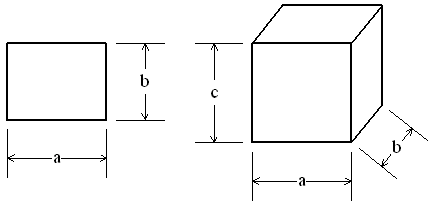The aspect ratio of an element is the ratio of the length of the element sides;
longest side / shortest side.
For surface elements (e.g. 2D continuum, plates and shells)
it is evaluated from max (a/b, b/a)
For 3D solid elements
it is evaluated from max (a/b, b/a, c/a, c/b, ...). The dimensions (a, b, c) are specified as follows:

In general, severe aspect distortion of an element will affect the
accuracy of the stress distribution as a result of ill
conditioning (round-off, truncation errors). As a result, LUSAS outputs a warning to
the output file if the element aspect ratio is greater than 1:10 (the analysis will
continue however). An ideal value would be a uniform ratio of 1:1 across the whole mesh,
but this is rather strict as well as unnecessary and values up to 1:10 should be
reasonable. The only exceptions to an increase in the aspect ratio in this way would be
the explicit dynamic elements that really do require aspect ratios as close to unity as
possible. Please see the following reference for further
information:
Help menu > Help
Topics > Contents > Element Reference Manual > Appendix
B : Element Restrictions > Excessive Aspect Ratios
Secondary reasons for this aspect warning are to indicate element shapes that may have
been generated inadvertently as a result of modelling mistakes in the geometry definition
as well as to reveal elements that span large sections of the model and, hence, may not be
able to simulate the actual stress field that is generated over this span.
Note that large values of aspect ratio do not necessarily mean inaccurate results since
the order of stress field that results from an analysis is also of importance. For
example, an element with a large aspect ratio will still yield a good distribution in the
presence of a constant uniaxial stress field, but not when subjected to a full stress
field in which the components vary significantly across the element (see "Implication: Quadratic vs. Linear Elements")
Aspect ratio warnings should always be investigated to ensure that modelling errors
have not been made as well as to ensure that elements having such associated warning are
not in areas of interest.
There is also a script which can be
downloaded and used to plot Contours of element aspect ratio after meshing a model to help you identify problem areas in the mesh where the mesh divisions specified need attention.
Also relevant here; the theory behind the
Jacobian matrix.
Finite Element Theory Contents
Ill-Conditioning